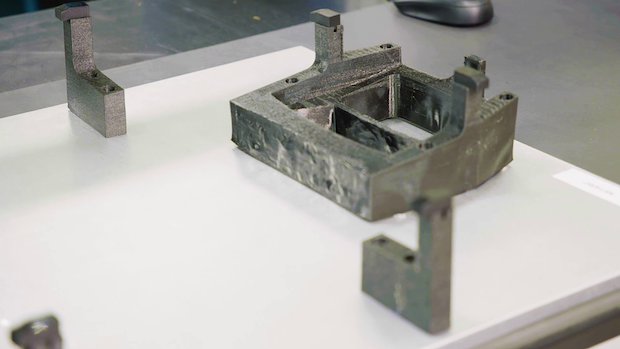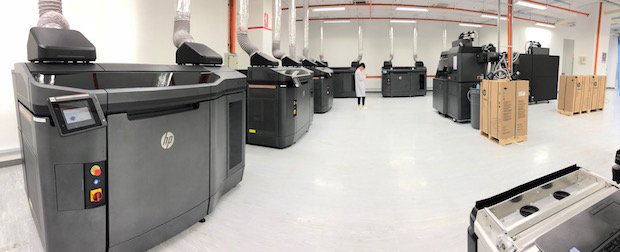Jabil, a global manufacturing solutions provider, has today introduced its Additive Manufacturing Network as it aims to enhance design and production efficiency.
The cloud-based network is used by Jabil internally and serves to drive its Distributed Manufacturing strategy, designing a part in one location and shipping production to another. It represents a manufacturing specialist taking full advantage of one of 3D printing’s key benefits, that you can design a part, save it in a file and when required manufacture and ship it within a matter of days, to save on time, storage space, and inventory costs.
Jabil is aware of what it takes to 3D print production parts, and aware of the importance of meeting the customer’s specified requirements. It serves players in industries from automotive to medical to consumer goods, and in order to satisfy, not only the customer awaiting the parts, but its own desires to maximise efficiency, has established the Additive Manufacturing Network.
“We have found that it is essential to have a platform that enables us to have the digital thread from design all the way through production, post processing, and delivery,” Tim DeRosett, Director of Product Management, Jabil Additive, told TCT. “And being able to connect multiple machines in different locations, and give access to multiple engineers, a platform like that did not exist. When you look at the ecosystem it was fairly fragmented but with additive we have the opportunity to really apply a true digital thread across the continuum, from part design all the way through production and delivery.”
By implementing this approach to manufacturing, Jabil is exploiting its global manufacturing presence and its extensive adoption of 3D printing technologies over the last few years. It now has upward of 100 additive manufacturing (AM) machines deployed in six facilities which so far make up the Additive Manufacturing Network. These centres are located in the United States, Mexico, Spain, Hungary, China, and Singapore, with more to be brought in as Jabil Additive grows.

The technologies it supports ranges from desktop machines to metal laser sintering platforms. Recently, the company revealed exactly how it is harnessing some of those smaller Fused Filament Fabrication (FFF) systems, while DeRosett also listed Jabil’s capacity to additively manufacture with higher performance FFF machines, as well as polymer and metal laser sintering technologies. Most notably, however, Jabil is a long-time partner of HP and now has a dozen of its Multi Jet Fusion (MJF) systems in place for production purposes, including six recently-installed 4210s in Singapore. Jabil has been handed responsibility by HP to manufacture many of the components that make up the MJF machines. In November, Jabil was manufacturing 50 parts for the 4200 machines, and just five months later is overseeing the production of 140 parts for the 300/ 500 full colour series. Much of this vast increase in production capability is down to Jabil refining the process, both in terms of the printing and post processing, and validating that workflow. And, as far as Jabil and HP can see, it’s a suitable example of how the Additive Manufacturing Network can be used: Jabil shipping the production of components to its Singapore base to serve HP’s own AM presence in the region.
“Working with Jabil has allowed us to fully leverage distributed manufacturing and create new efficiencies in our production process across far-flung locations,” offered Stephen Nigro, HP’s President of 3D Printing. “Together, Jabil’s Additive Manufacturing Network and our Multi Jet Fusion printers have helped optimise the high-volume production of functional parts for our own 3D printers, and shown how traditional supply chains are being upended and reinvented for the digital manufacturing age.”
Jabil’s Singapore facility is key to its Digital Manufacturing strategy and the new Additive Manufacturing Network. The country has great industrial strength and Jabil and HP alike are keen to take advantage of that. Jabil has deployed product designers and manufacturing teams at the location in Singapore and has recently received ISO9001 at the facility, ensuring its HP Multi Jet Fusion production process is compliant with the quality management system certification. Securing this accreditation, Jabil utilised Failure Modes and Effects Analysis (FMEA) tools, as well as process control documentation. It enabled Jabil to conduct fairly extensive analysis of the HP MJF parts, and though each application will bring different requirements, stands the company in good stead as it brings the 3D printers at the Singapore base online, ready to use as part of the AM Network.

“For folks that have been in manufacturing, they understand ISO9001 quite well and they understand FMEA quite well,” DeRosett said, “and those are what I would refer to as the blocking and tackling of manufacturing, and that’s what we’re bringing to additive.”
The ‘blocking and tackling’ of manufacturing represents the fundamentals, but Jabil’s ambitions go way beyond that. Singapore is a key part of its AM Network, but the cloud-based platform will eventually require efforts from more than just six locations. But even at half a dozen facilities, DeRosett still sees it as the ‘glue that connects all of the supply chain and manufacturing systems into one thread.’ Jabil has set up a network with the utmost flexibility, all locations boasting the required design and manufacturing proficiencies to serve customers at a global scale. The company’s network also offers traceability, Jabil always in the know with regards the progress made on a work order, and securely able to monitor that progress. Once production has been shipped to a location, the design has been validated and locked down, meaning staff at the manufacturing base need to contact the design facility should they wish to make alterations. It’s a system Jabil believes to be unique, but one that makes sense, particularly when you take into account the company’s plans to make digital manufacturing at scale a reality.
“When you think out to the future, and how additive can potentially transform the supply chain, and to go from production sites where you have warehouse stocked full of working process parts or components or sub-assemblies, and to go to an additive approach, where your inventory is in digital files and raw material, and when you need the part you simply send it to the printer and you have a finished part in a matter of a couple of days, that I think is very transformative,” DeRosett asserts. “We’re not going to get there overnight, obviously, but I think this is a big step to have the foundational capabilities to move in that direction.”
“Jabil’s digital thread fuels a growing footprint of 3D printers and additive manufacturing capabilities to benefit customers through localised production, consolidated supply chains, reduced costs and faster time-to-market,” John Dulchinos, Jabil’s Vice president of Digital Manufacturing, commented. “Our new Jabil Additive Manufacturing Network is the connective tissue that scales globally to integrate every printer, facility, and work order across our enterprise and crystallise our vision of truly distributed manufacturing.”









